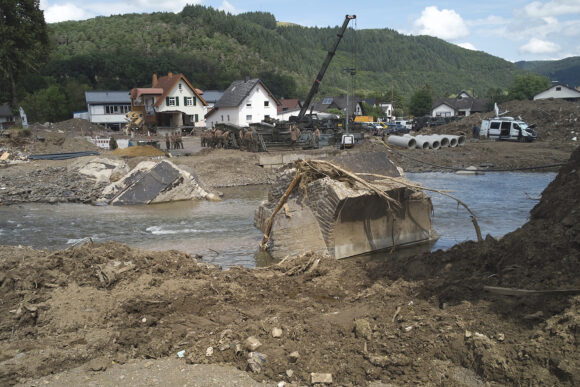AIR Worldwide, the Boston-based catastrophe modeling firm, estimates insured losses in Germany from July flooding could approach €5 billion ($6 billion).
Low pressure system “Bernd” parked itself over central Europe and brought about significant flooding from July 13 to 18, said AIR in a description of the event. Germany’s Rhineland-Palatinate and North Rhine-Westphalia regions were particularly affected, experiencing heavy and, in some cases, historic levels of rainfall. The border region between the German states of Bavaria, Thuringia, and Saxony was also affected by localized flooding.
German rivers with notable gauge readings during storm Bernd include the tributaries of the Mosel and Rhine rivers, some of which reached historically high levels, said AIR, pointing to one especially hard hit region – the Ahr valley, named after the Ahr River, a tributary of the Rhine River in Germany. “All along the Ahr River, homes were flooded and bridges were broken; in the village of Schuld, most buildings were destroyed.”
Also heavily affected were the mountainous areas in the border region between the southeasternmost region of Germany and the Austrian states of Salzburg and Tirol. Communities in the German state of Saxony were also affected – especially in the mountain range Saxon Switzerland.
Read more: Germany’s Floods Will See ‘Sizable’ Protection Gap. Could Insurance Demand Increase?
The restoration of infrastructure such as water and gas pipes, power lines, and roads could take weeks or even months, according to some estimates, which could lead to loss inflation effects.
AIR noted that many reinsurance contracts are subject to an hours clause (typically 504 hours for flood events). Given the duration of this event, AIR expects the flood to be treated as a single occurrence in Germany.
To produce the loss estimates, AIR analyzed hourly precipitation fields over Germany, derived from NASA’s Global Precipitation Measurement (GPM) system, during July 5 to 19. Daily observed rainfall data from over 1,600 gauging stations, obtained from the Climate Data Center at Deutsche Wetterdienst (DWD), was also assimilated to improve the quality of the GPM precipitation input.
As the vast majority of losses for this event within Germany came from the catchments of the Rhine and Danube basins, the loss estimate is limited to these two river basins within Germany, explained AIR, a subsidiary of Verisk.
River flow data from more than 900 gauging stations in the Rhine and Danube river basins within Germany, obtained from country’s provincial and federal agencies, was used to calibrate and validate the modeled flows.
Included in AIR’s estimates are losses to insured physical damage to property (residential, commercial, industrial, auto, agriculture), both structures and their contents, from both on- and off-floodplain flooding. Other countries and regions that experienced flooding include Belgium, Switzerland, Austria, Luxembourg, and the Netherlands’ southernmost province Limburg, but these regions are not included in AIR’s loss estimate.
Source: AIR Worldwide (AIR)
Photograph: German Armed Forces begin to erect a temporary bridge over the river Ahr at Insul, Germany, on Monday July 26, 2021, after devastating floods. Recent heavy rains caused deadly floods across the region, with some thousands of people displaced as towns and villages were inundated. Photo credit: Thomas Frey/dpa via AP.
Related:
- Climate Models May Have Underestimated Impact of Extreme Weather Events
- Deadly Floods in China, Europe Send Stark Reminder of Climate Change Vulnerabilities
- German Floods Will Be Expensive but Unlikely to Burn Through Insurers’ Earnings: Fitch
Topics Profit Loss Flood
Was this article valuable?
Here are more articles you may enjoy.



 CEOs on Guard as Trump Rattles Companies With Series of Edicts
CEOs on Guard as Trump Rattles Companies With Series of Edicts  Georgia Republicans Move to Scrap State Income Tax by 2032 Despite Concerns
Georgia Republicans Move to Scrap State Income Tax by 2032 Despite Concerns  Expense Ratio Analysis: AI, Remote Work Drive Better P/C Insurer Results
Expense Ratio Analysis: AI, Remote Work Drive Better P/C Insurer Results  Consumer Acceptance of Telematics Widens, Says Survey
Consumer Acceptance of Telematics Widens, Says Survey 

